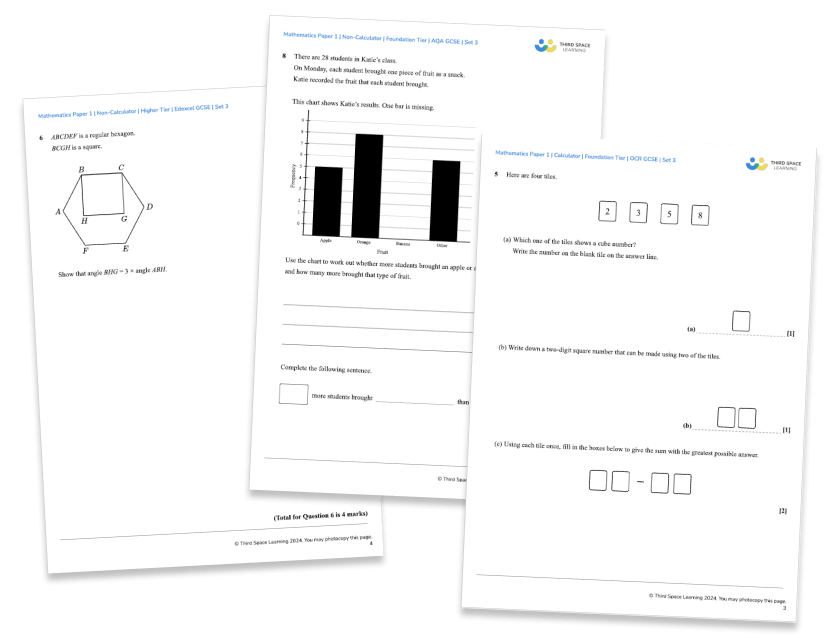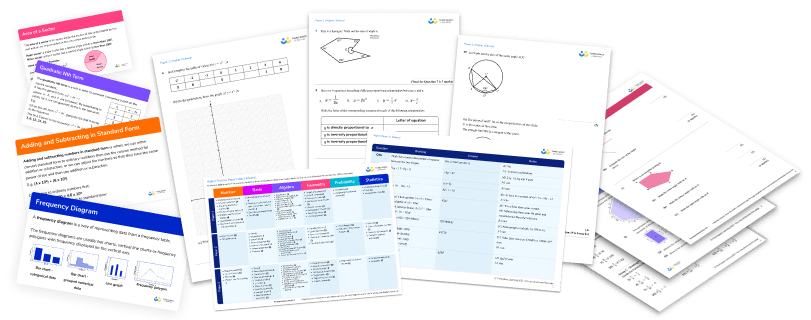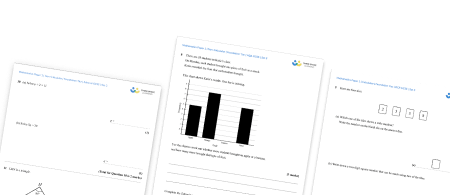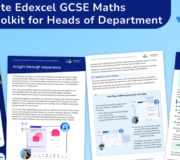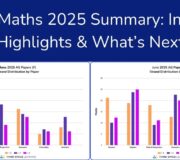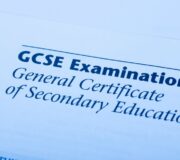Overview Of All GCSE Maths Topics And The Resources You’ll Need To Teach Them
Here we look at all the GCSE maths topics that make up the syllabus of each exam board. Look out for links to the free GCSE maths resources available for each topic for your students.
These are the 6 main GCSE maths topics for both Foundation and Higher:
- Number
- Algebra
- Ratio, proportion and rates of change
- Geometry and measure
- Probability
- Statistics
These topics apply across Edexcel, AQA and OCR. More detail is provided below for each of them.
Looking for a revision list of GCSE maths topics?
If you’re just interested in downloading a GCSE maths revision checklist of all the sub-topics to tick off, then these GCSE maths topic lists are what you need (available for Foundation and Higher). Each entry links to our popular and detailed GCSE maths revision guides with accompanying practice questions.
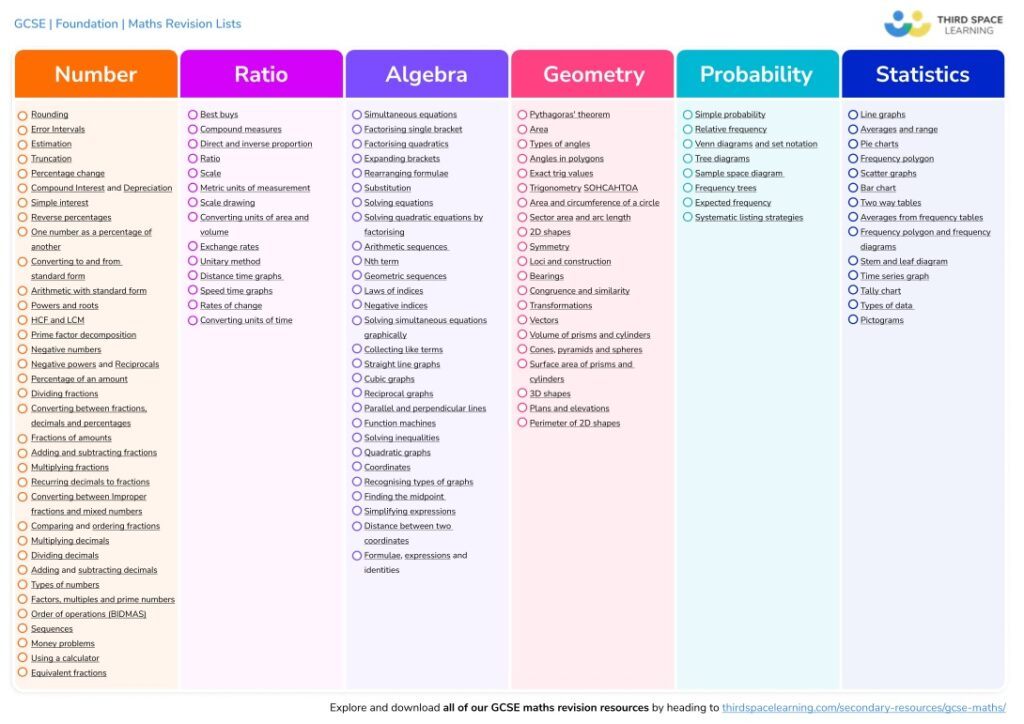
GCSE MATHS 2026: STAY UP TO DATE
Join our email list to stay up to date with the latest news, revision lists and resources for GCSE maths 2026. We’re analysing each paper during the course of the 2026 GCSEs in order to identify the key topic areas to focus on for your revision.
GCSE dates 2026
GCSE results (2026 when available)
Get ahead on revision with the GCSE maths papers analysis from 2025:
Analysis of GCSE Maths Paper 1 2025
Analysis of GCSE Maths Paper 2 2025
GCSE Maths Paper Analysis and Summary 2025
GCSE Maths Teacher Survey Results 2025
Edexcel, AQA and OCR Foundation and Higher Papers: Set 3 (2024)
Download this free pack of of practice papers for GCSE maths - bespoke versions for Edexcel, AQA and OCR
Download Free Now!Overview of the GCSE maths topics
There is minor difference across exam boards but this is a summary of what is in each GCSE maths topic.
- Number: This topic covers fractions, decimals, percentages, ratios, arithmetic operations, calculations, and more.
- Algebra: This topic covers equations, inequalities, sequences, graphs, powers, roots, notation, and more.
- Ratio, proportion, and rates of change: This topic covers ratios, proportions, and rates of change.
- Geometry and measures: This topic covers properties of shapes, angles, area, volume, constructions, and trigonometry.
- Probability: This topic covers probability.
- Statistics: This topic covers statistics.
In addition, there are three assessment objectives that will be tested:
- AO1: Use and apply standard techniques
- AO2 Reason, interpret, and communicate mathematically
- AO3: Solve problems within mathematics and in other contexts
These are all taken from The DfE’s subject content and assessment objectives for GCSE mathematics.
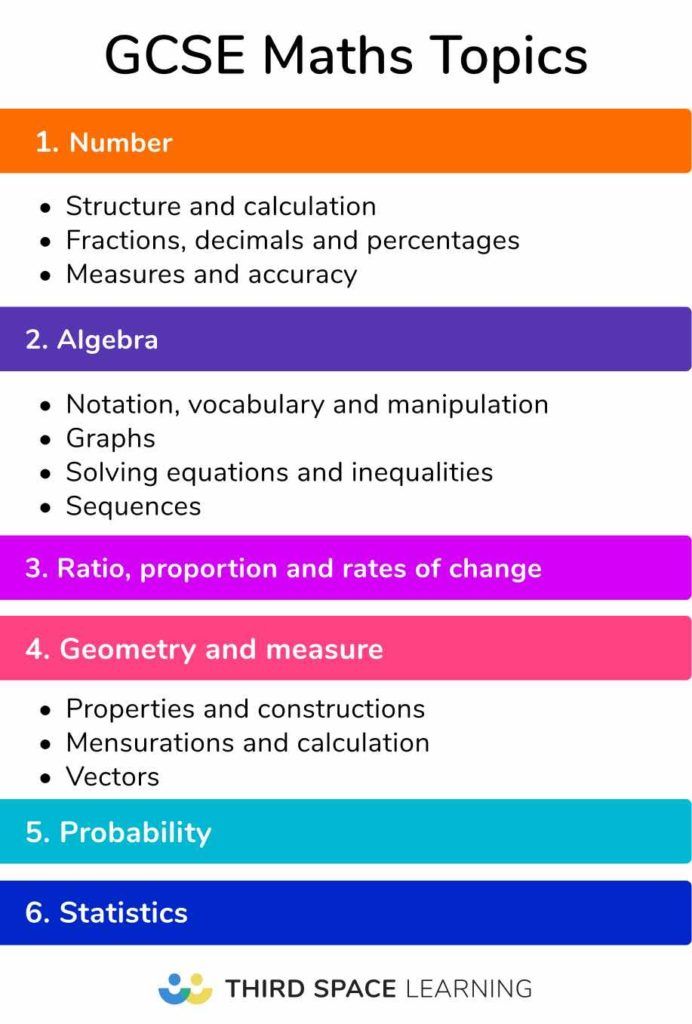
Foundation or Higher tier GCSE maths?
Each of the exam boards offer two tiers of exams: Foundation and Higher. The Foundation tier has a slightly more limited set of topics and is for students aiming for grades 1–5, while the Higher tier is for grade 4–9 students.
If you’re teaching students aiming for higher tier maths, then take a look at the equivalent higher maths article.
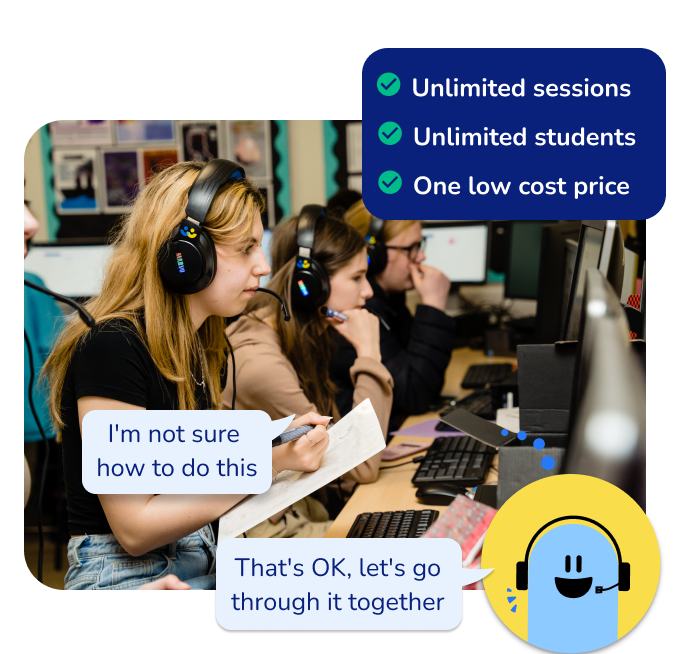
Unlimited GCSE maths tutoring with Skye, the voice-based AI maths tutor.
Built on the same principles, pedagogy and curriculum as our traditional tutoring but with more flexibility, reach and lower cost.
Help your GCSE students achieve their target grade with Skye’s one to one maths tutoring.
Watch Skye in actionMost important GCSE maths topics
As a maths teacher of course I would say that all GCSE maths topics are important.
What we have done here however is look at all the maths topics you’ll need to cover for Edexcel, OCR AQA but with the added expertise provided by our long running analysis of the kinds of questions and topics that come up each year on the maths papers.
Where we refer to topics that may have appeared on past papers, or content of past paper questions, this draws on our extensive research and analysis of all the Edexcel foundation maths papers since 2017.
When you start your preparation for the GCSE exams, it is helpful to have some data to back up how you prioritise the GCSE maths revision.
Knowing the topics that are assessed frequently and widely across the papers, the ones that do not appear as often, and those that tend to be assessed in particular ways can make a real difference. Exam preparation and revision should take place in this context, allowing students more time to focus on the skills which typically attract more marks.
This article looks at the specific topics and approaches you can use to maximise revision time with your students and minimise exam anxiety.
For each of the GCSE maths topic areas below, we’ve provided links to the relevant GCSE maths revision guides. In each guide, you’ll find step-by-step examples, practice questions, exam questions, and a worksheet.
How this knowledge is applied to our GCSE tutoring with Skye, the AI tutor
GCSE maths is interconnected, and that’s how our GCSE AI maths tutoring is structured. Skye, the AI maths tutor, focuses on each individual high-value lesson as part of an interconnected web, rather than teaching any topic independently. Skye adjusts the teaching depending on the student and their level.
Within the individual lessons, slides follow a similar structure:
- Start with a warm-up question which allows for some initial assessment
- Move swiftly to the lesson which is divided into three three learning objectives, which cover the topic.
- Each learning objective includes an exam-style question, a ‘support’ slide and an ‘assess’ slide.
- Additional pre-cursor slides are available to use in response to the needs and learning gaps of the student.
- Lesson ends with the option of a ‘challenge’ slide to support the development of mastery of that topic, and build confidence with more challenging questions.


1. GCSE maths topic: Number
Key number topics for GCSE
- Context-rich work on four operations and calculation skills, including basic arithmetic, fractions, decimals and negative numbers, order of operations.
- Real-life contexts including bank accounts, utility bills, wage increases, recipes, and best-buys.
- Procedural work on place value, standard form, indices, rounding and estimation, factors, multiples, HCF, LCM and product of primes.
Infrequently appearing number topics
- Problem-solving or rich problems using HCF, LCM, product of primes, standard form.
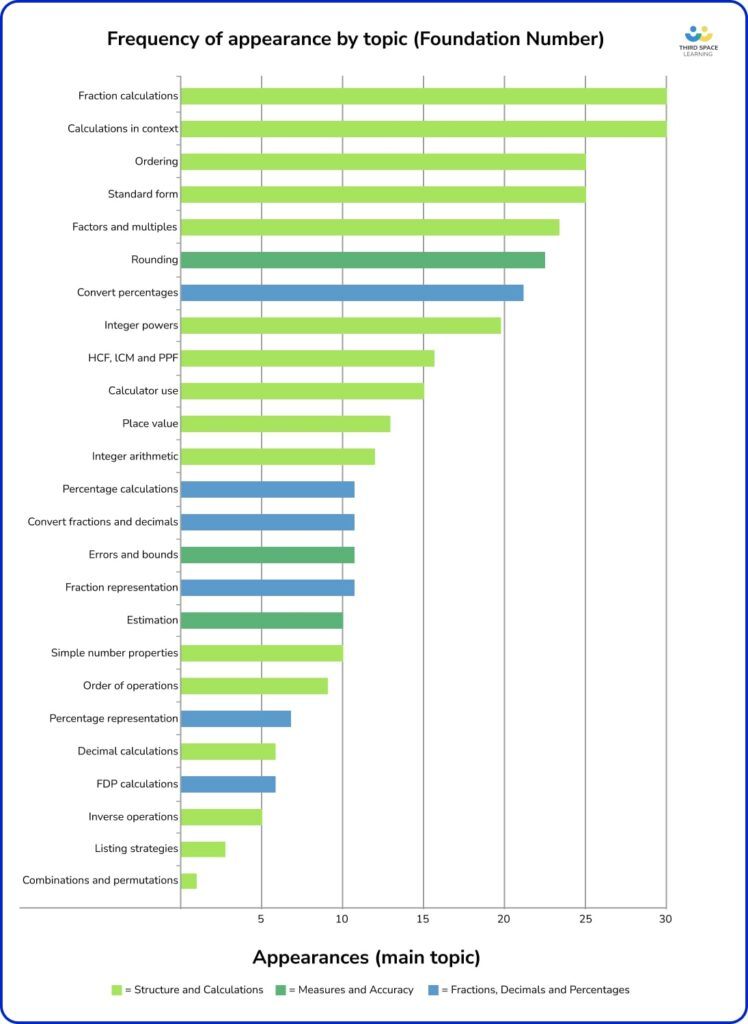
What do we know from the GCSE paper analysis?
One thing highlighted by the GCSE paper analysis is that numeracy skills and proportional reasoning are the backbone of the current GCSE Foundation programme of study. A significant amount of this is assessed in a non-standard manner or using ‘real-life’ contexts. At Foundation, being able to work confidently with arithmetic and apply this to unfamiliar problems is absolutely key.
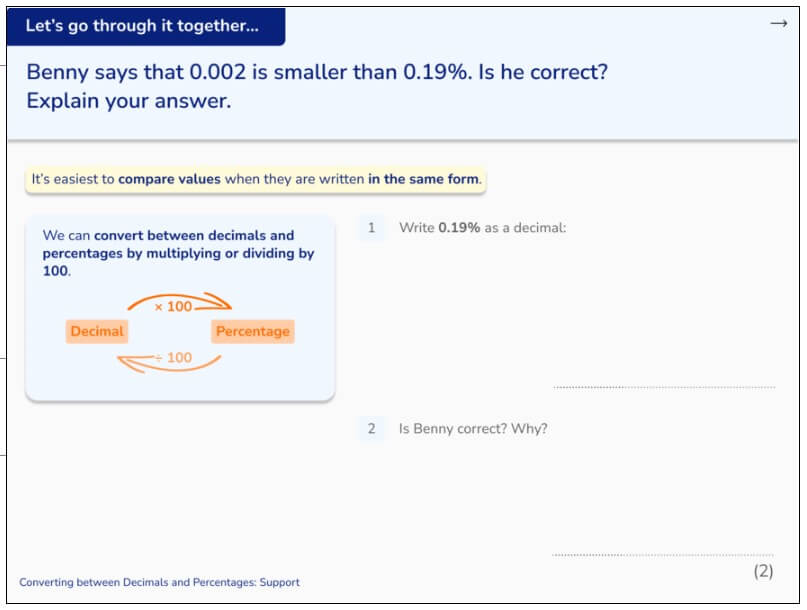
It was clear from the Sample Assessment Materials, and the messaging from exam boards, that one of the goals for GCSE maths 2015 was to increase the demand in problem-solving, and also to ask more questions requiring connections to be made between topics. This I expect to be a regular theme of these papers.
What should you be teaching this year?
Students need plenty of practice on number skills (four operations including fractions and decimals, calculations, percentages etc) so these are not limiting their ability to access the context-based problems. Ample time and opportunity should also be spent working with number skills in a wide variety of contexts; these should include more common real-life contexts such as:
- Shopping and best buys
- Planning the cost of a holiday
- Calculating deposits and monthly payments
- Meter readings
- Working out quantities of materials needed for decorating/gardening
Some number topics are typically assessed in a fairly procedural or context-free way; these include:
- Place value and standard form
- Ordering
- Order of operations
- Inverse operations
- Powers and roots
- FDP conversions
- Rounding and estimation
While there is some lovely rich teaching content in these topics, it is less likely to be assessed on GCSE Foundation. That said, there is very little content in the number and proportion strand that could be considered non-essential.
2. GCSE maths topic: Algebra
Key algebra topics for GCSE
- The ‘algebra toolkit’ of simplifying, expanding, factorising, laws of indices, which ensures that students can reliably apply methods to standard problems.
- Solving linear equations and inequalities.
- Applying mathematical formulae to a variety of real-life and unfamiliar contexts.
- Sequences, functions and graphs, with focus on procedural ‘easy wins’ in graph work and sequences.
Infrequently appearing algebra topics
- Quadratic equations, particularly factorising and solving the form x2 + bx + c = 0.
- Limited work on quadratic expressions.
- Algebraic vocabulary (identify formula/equation/identity etc).
- Finding terms in quadratic and geometric sequences.
- Cubic and reciprocal graphs.
- Parallel lines.
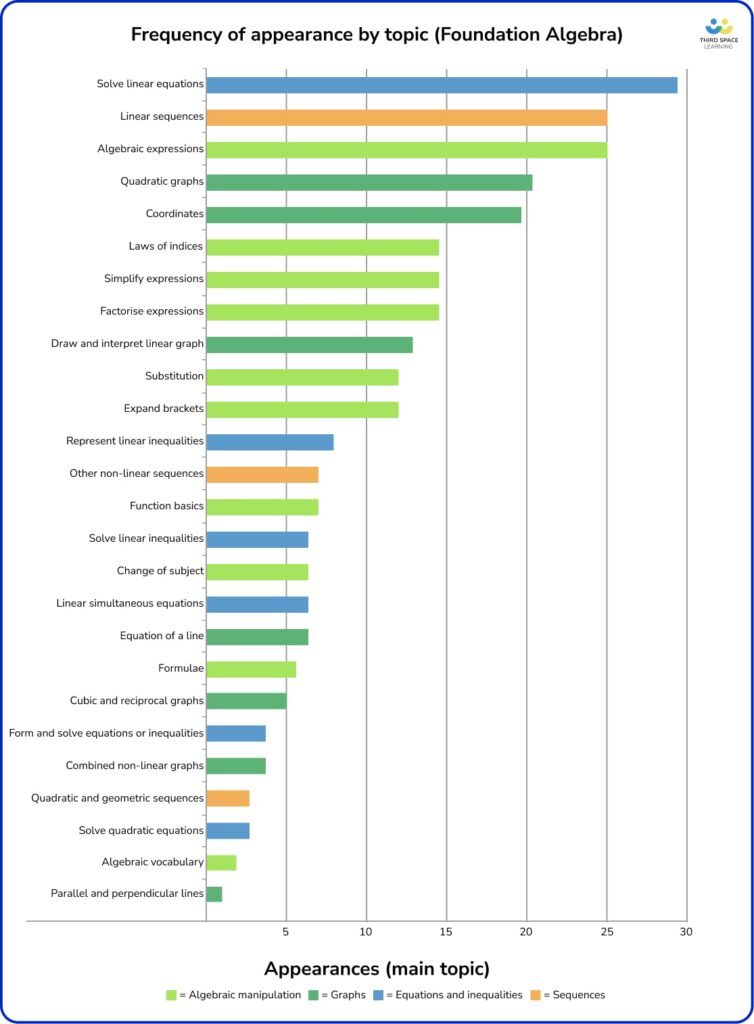
What do we know from the GCSE paper analysis?
In the Foundation tier, a significant amount of algebra is assessed in procedural, context-free ways; this suggests there is less value in spending a lot of vital exam preparation time on rich problems for these topics. It is worth remembering that, while the complexity and degree of problem-solving expected for algebra at Foundation is relatively low, students find the topics themselves more challenging, and so these are not necessarily easier marks.
Furthermore, we need to consider the frequency at which high-end algebra topics, such as parallel lines, quadratic and geometric sequences, non-linear graphs (other than quadratics), quadratic expressions and equations, appear on Foundation papers, and think critically about the amount of teaching time spent on these for borderline grade 4/5 candidates.
What should you be teaching this year?
It is crucial that students’ basic algebra skills are secure, focusing on fluency and the ability to tackle procedural problems over significant amounts of problem-solving or rich content. I would consider spending less time on the less frequently occuring topics listed above, in favour of more time on graphs, sequences and functions, particularly as these are traditionally tackled poorly by candidates.
The 2018 Chief Examiner’s report states that “beyond drawing a simple graph of an equation, there appears to be little understanding of the relationship between equation[s] and graph[s], between graphs of parallel lines, or finding an equation from a straight-line graph.”
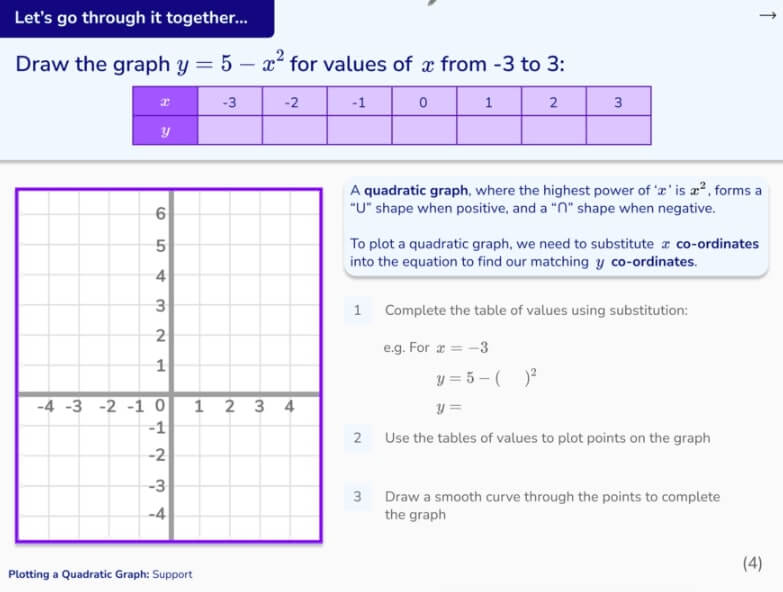
Although problem-solving in Foundation algebra is fairly limited, it is worth ensuring that grade 4/5 students can apply algebra skills to geometry problems (e.g. Nov21 1F Q16), many of which require them to form and solve an equation or inequality.
3. GCSE maths topic: Ratio and proportion
Key ratio and proportion topics for GCSE
- Context-rich problems requiring students to work flexibly with fractions, percentages and ratios.
- Splitting into a ratio and combining ratios, particularly in context.
- ‘Number-puzzle’ problems where students are asked to work out a missing amount when the other proportions are given as a mixture of fractions, percentages, and ratios (e.g. June 2018 P1 Q14).
- Time calculations, particularly misconceptions around fractions of an hour, and the use of a calculator for time problems.
Infrequently appearing ratio and proportion topics
- Inverse proportion
- Real life graphs that aren’t speed, distance and time

What do we know from the GCSE paper analysis?
There is a large amount of problem-solving at Foundation within Ratio and proportion, particularly direct proportion (recipes, best buys etc), using ratio notation, splitting into a ratio and combining ratios. Compound measures also contains a lot of problem-solving or context-based work, and has appeared on almost all series to date.
There are some topics that are more likely to be assessed procedurally, including:
- Distance- and speed-time graphs
- Standard measures (i.e. unit conversions)
- Proportion graphs
- Reverse percentages
- Simple and compound interest
What should you be teaching this year?
Speed, distance and time featured more heavily than other compound units work, such as pressure or density, and most real-life graph work also uses distance-time or speed-time graphs. That said, a strong understanding of all compound measures work is vital, particularly for students aiming for a grade 4 or above.
Addressing misconceptions around fractions of an hour, and the use of a calculator for time problems is also extremely useful. Quite a lot of the content here (such as compound measures, reverse percentages and repeated percentage change) tend to appear in crossover content towards the end of the paper, so these are crucial skills for grade 4 and 5 candidates.
4. GCSE maths topic: Geometry and measure
Key geometry and measure topics for GCSE
- Perimeter, area and volume, particularly context-based problems
- Applying compound measures to shape problems (e.g. use density with volume of a shape)
- Scale drawing work and bearings
- Procedural work on 2D shape (such as polygons) and angle properties (particularly angles on a line, around a point, in a triangle) and vectors
Infrequently appearing geometry and measure topics
- Constructions and loci
- Trigonometry, particularly exact values
- 3D shape and angle properties
- Surface area and volume of spheres, cones and pyramids
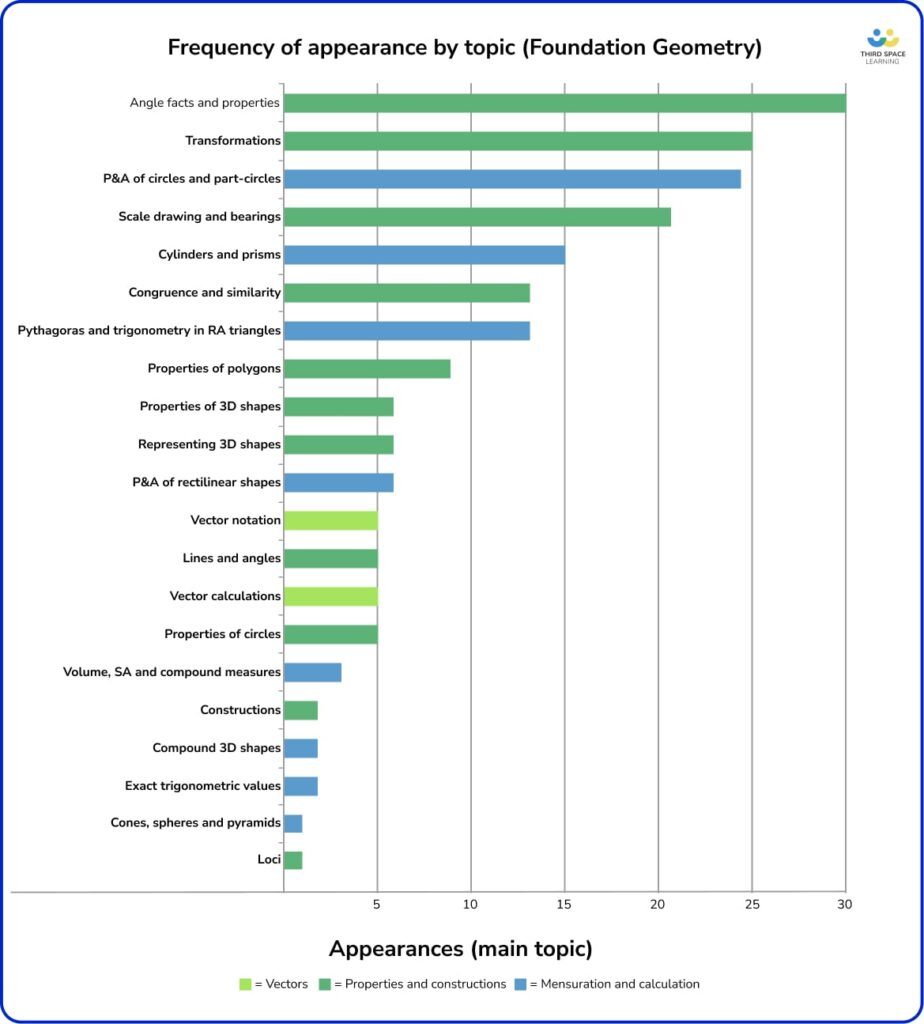
What do we know from the GCSE paper analysis?
One thing I noted from the Edexcel paper analysis was a large amount of problem-solving based on perimeter, area and volume. There were relatively few procedural problems, instead of real-life contexts and unfamiliar abstract situations. As well as ensuring students can reliably apply standard methods, they must apply these skills to other problems.
What should you be teaching this year?
Students should be given plenty of practice on problem-solving and context-based problems in units on perimeter, area and volume. Typical contexts include:
- Calculating costs for fencing or boundaries (e.g. Jun18 2F Q19)
- Covering an area with grass seed, paving slabs or paint
Many similar shapes involved in area work are standard: squares, rectangles, triangles and circles, with less on compound shapes. Also featuring highly is crossover work with compound measures. Density and pressure are linked fairly frequently with volume or area calculations.
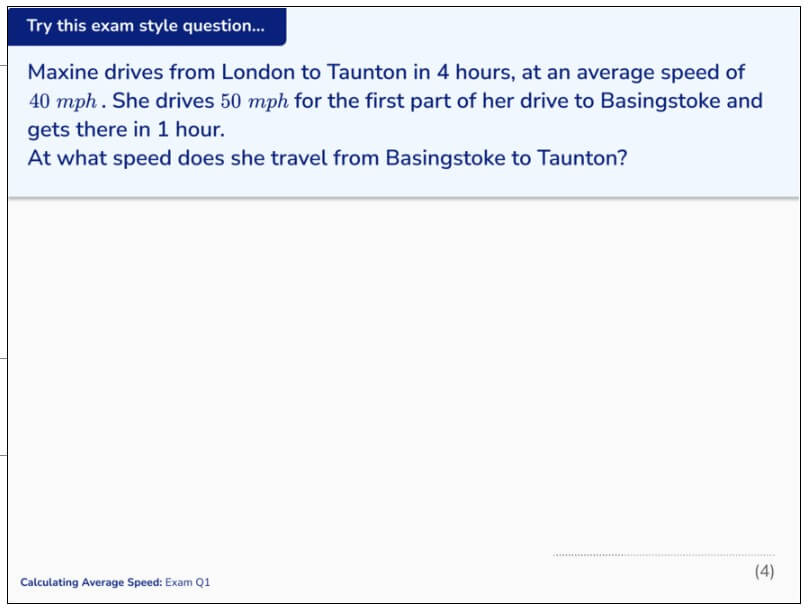
I would also recommend plenty of coverage on the correct use of mathematical equipment, such as scale drawing work and bearings, as these come up frequently for a fair number of marks, and students may have had varying degrees of success working on these remotely.
3D shape properties can represent easy wins, but come up relatively infrequently.
The traditionally ‘higher’ surface area and volume work, such as spheres, cones and pyramids, also comes up infrequently, so it might be advisable to skim this in favour of spending more time on, for example, problem-solving using circumference and area of a circle.
5. GCSE maths topic: Probability
Key probability topics for GCSE
- Procedural work on listing outcomes, Venn diagrams, frequency trees
- Application of fraction, decimal and ratio skills to problems about mutually exclusive events
Infrequently appearing probability topics
- Tree diagrams
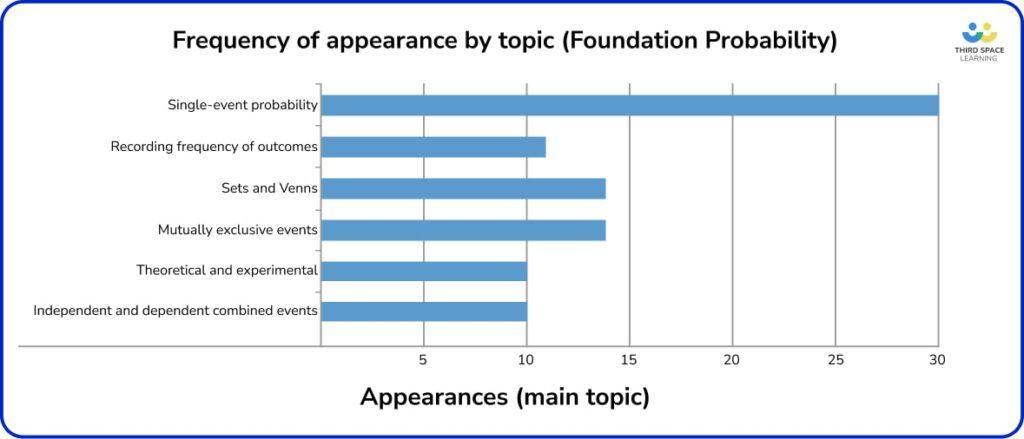
What do we know from the GCSE paper analysis?
Like algebra, a significant amount of probability and statistics is assessed at Foundation in procedural, context-free ways. Again, there is less value in terms of exam preparation in spending lots of time on rich problems.
What should you be teaching this year?
In the probability strand, one topic that does attract a fair amount of non-standard problems is mutually exclusive events, which often embed skills using fractions or ratios, so it is worth focusing on problem-solving skills there.
Procedural work on ‘newer’ topics such as Venns, listing outcomes and frequency trees would be valuable, as these topics seem to appear frequently. In fact, frequency trees were heavily favoured over standard tree diagrams, so I would be tempted to skim the latter, plugging gaps once advance information has been released if necessary.
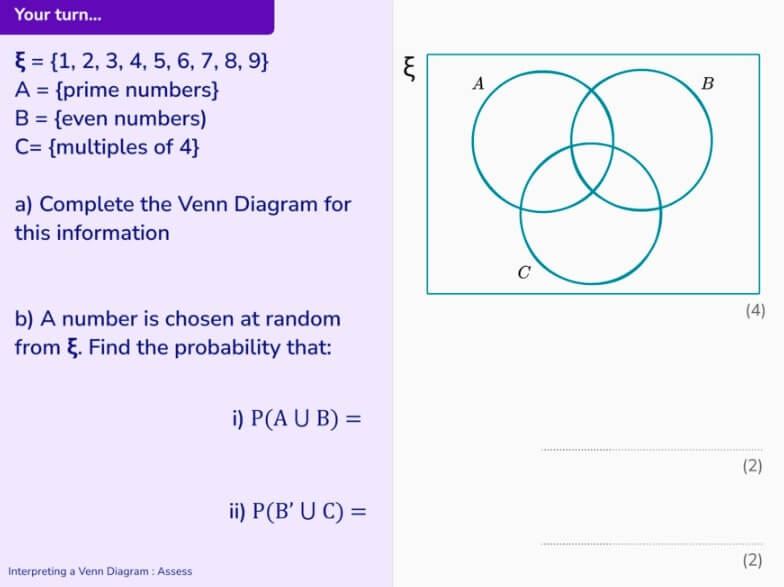
6. GCSE maths topic: Statistics
Key statistics topics for GCSE
- Presenting data; drawing and interpreting a wide variety of graphs
- Estimating the mean
Infrequently appearing statistics topics
- Frequency polygons
- Data collection and sampling
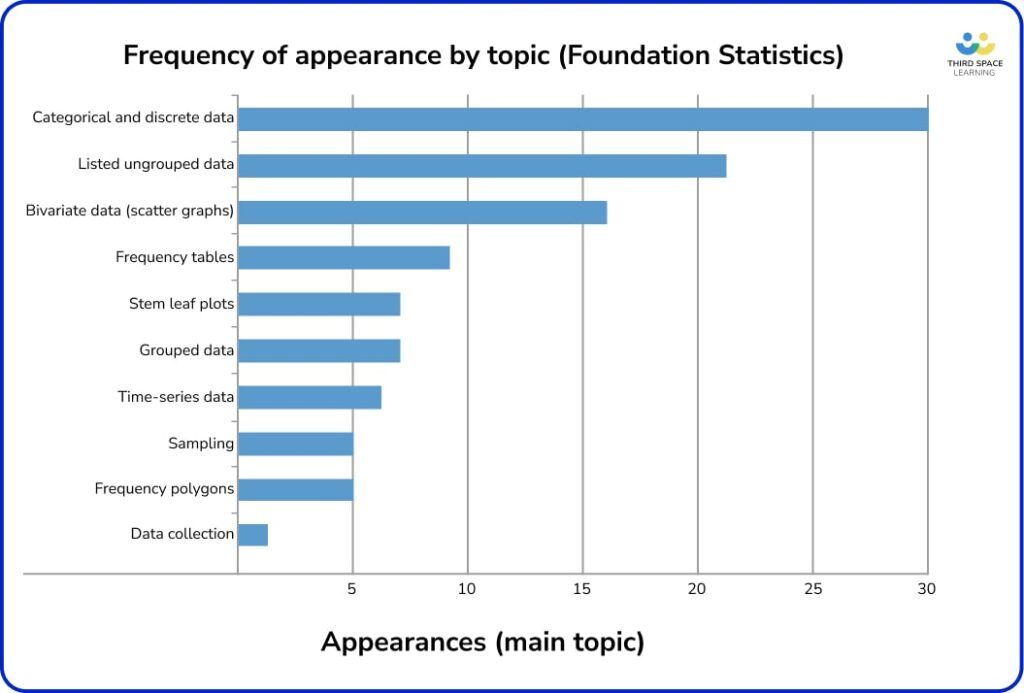
What do we know from the GCSE paper analysis?
Similar to algebra and probability, much of the statistics at Foundation level is assessed procedurally, so more focus should be given to procedural fluency over engaging with rich problems when considering exam preparation.
What should you be teaching this year?
In statistics, the emphasis is more heavily on presenting data rather than processing data, with equal focus on drawing or completing charts and graphs, and interpreting or critiquing existing representations. Pictograms and pie charts feature frequently, with fewer bar charts. Scatter graphs usually include a drawing and interpreting component. Estimating the mean comes up on quite a few papers. Data collection and sampling does not appear on every series, and questions can usually be answered in a fairly intuitive way.
Teaching strategies for these GCSE maths topics
Based on analysis across all GCSE maths papers (Foundation) since 2017, the following points become clear:
- Continue to emphasise number and proportion work, particularly in applying these in other contexts.
- Revise and practice basic numeracy work.
- Standard procedures, such as expanding, factorising, simplifying, and using formulae need work too.
- We need to ensure that students are familiar with connections within the Foundation content eg
– using linear equations to solve 2D shape and angle problems
– using fractions and ratios in probability calculations. - For lower-attaining students spend less time on rich content and problem-solving within those select topics in number, algebra, and most of statistics which are unlikely to come up in the exam.
Which GCSE maths topics appear early in the paper?
GCSE maths topics in the first five questions
The first five questions of Edexcel Foundation papers consist mainly of one-mark standard procedural questions. They’re designed to ease students into the paper, as well as testing key skills in a simple manner. Many of the topics in this section are absolutely fundamental to success in GCSE Maths, so these could be skills to target with frequent retrieval practice.
To summarise briefly, there is:
- A heavy skew towards Number topics
- Some inclusion of simple Algebra and Ratio and proportion topics
- Very little Geometry or Statistics, no Probability
The most frequently appearing topics are:
- Metric unit conversions
- Place value calculations
- Rounding to integers
- Ordering integers, fractions and decimals
- Factors and multiples
- Convert between FDP
- Find fractions of amounts
- Algebraic notation/simplify (easier)
- Order of operations
- Calculator use
- Square and cube numbers and their roots
GCSE maths topics in the first ten questions
Expanding to the first ten questions on the paper, we see a much wider range of topics cropping up. The next five questions (Q6-10) contain a much wider mix of topics, more reflective of the general proportions of the paper. Most lower-grade Foundation topics appear somewhere in here on one series or another, but there are a few very common topics or types of questions that crop up between question 6 and 10 on most papers. Interestingly, there is also a greater proportion of Statistics in Q6-10 compared to the whole paper.
The most frequently appearing topics in Q6-10 are:
- Money calculations
- Probability scale
- Using coordinates in four quadrants
- Bar chart
- Pictogram
- Time calculations
- One-step linear equations
- Simple averages and range
- Using correct algebraic notation
- Parts of a circle
- Angles at a point, on a line, vertically opposite
Common crossover GCSE maths topics
Crossover or common questions are those which appear on both tiers of paper. On average, this is around 20-25 questions per series, split over three papers. So a typical Foundation paper will contain approximately 8 common questions (often split into parts), carrying nearly a third of the overall marks per paper.
The most frequently appearing common questions are on the following topics:
- Quadratic graphs
- Compound measures
- Standard form
- Scatter graphs
- HCF, LCM and PPF
- Pythagoras and trigonometry in RA triangles
- Writing as a ratio
- Ratio and fraction links
- Combining ratios
- Laws of indices
- Sets and Venns
- Angle facts and properties
- Fraction calculations
A note on Foundation and Higher tiers at GCSE
When deciding tiers, bear in mind that when the new 2015 specification came in, exam boards encouraged more Foundation entries. This was particularly encouraged for those who would be previously considered ‘weak grade Cs’. This messaging has not changed; exam boards are keen to dissuade Higher entries for candidates unable to access the majority of the paper.
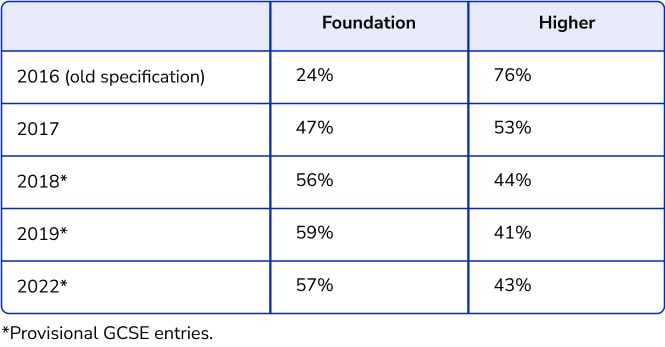
We can see that the most recent live exams have settled at just over 40% of candidates being entered for Higher, a large contrast to the pre-2015 specification, where over three-quarters of candidates were regularly entered for Higher.
A recent development relevant to tiering decisions is Ofsted’s Coordinating Mathematical Success report, which suggests that tiering decisions are being made too early, are restricting the KS4 curriculum and having a negative impact on students’ experience of mathematics. The report acknowledges that external pressures are often the driver of this, and it will be interesting the implementation of their recommendation that the DfE and Ofqual explore this further.
That said, it is definitely appropriate to leave tiering decisions later for some groups, particularly those identified in typical “borderline 4-5” teaching groups. For these students, a decent grasp of and fluency with all crossover content is vital. There are also some topics that appear on the Higher paper only that can be cherry-picked as easier marks, or often asked in more procedural ways. Generally speaking, you’re looking for topics that satisfy one of these criteria:
- Encountered at Foundation, but may be asked with more context, complexity or a deeper problem-solving element (such as reverse percentages).
- Build in small steps on key top-end skills at Foundation (such as expanding triple brackets).
- Higher-only stand alone content that’s accessible and is unlikely to be included in multi-topic problems (such as box plots or cumulative frequency).
GCSE maths topics to teach borderline students
This suggested starting topic list is based on the most frequently occuring, highest scoring topics in the first half of the Higher paper, excluding crossover content.
Topics in italics are Higher-only.
- Calculating using standard form, including context-based
- Laws of indices, including positive fractional powers and simple negative powers
- Product rule for counting
- Find and interpret gradient in context
- Simultaneous equations, including writing from contexts
- Expand triple brackets
- Add and subtract algebraic fractions
- Compound interest and depreciation
- Percentage change and reverse percentages, usually with some element of problem-solving
- Density, mass, volume
- Use Pythagoras’ theorem in context
- Find missing sides and angles using trigonometry
- Similar areas and volumes
- Enlargements (positive and negative scale factors)
- Sine rule and cosine rule
- Circle theorems
- Tree diagrams
- Box plots (draw and interpret)
- Cumulative frequency graphs (draw, interpret, estimate values)
Additional free resources for all GCSE maths topics
- GCSE Fluent in Five Arithmetic Pack to build arithmetic skills and mathematical fluency through regular daily practice
- GCSE Exam Questions: in the settler/starter portion of the lesson, focus on five or ten key topics for a few weeks at a time
- Diagnostic Questions are ideal for identifying misconceptions as part of continual, low-stakes formative assessment. regular mini-quizzes, or using the starting portion of the lesson for a Top 5/10) is more crucial than ever for identifying gaps in learning.
- These articles are designed for Year 11 teachers and students: How to revise for GCSE, How to revise for maths
- Take a look at the GCSE grade boundaries to help support those students on the cusp.
A note on the GCSE maths exam in 2025
The past few years have been very challenging for the education sector, particularly in the domain of examinations (or lack thereof) and assessments. With the complications of teacher-assessed grades and advanced information behind us GCSEs are now back to their previous pre-pandemic form.
Except: The formula sheets which were given in maths, physics, and combined science in 2024 as a concessionary measure for students who had experienced learning disruption due to the pandemic will still be available in 2025. Candidates will still benefit from memorising some of the key GCSE maths formulae as it’s surprising how fast the time goes and how long you can spend looking them up.
Download free: GCSE Maths formula booklet
Building maths skills for the future
There is a balance to be struck between preparing students for their GCSE maths exams and providing them with skills for onward life and study. We must be mindful that the sole purpose of education is not to enable students to pass exams. This point has been raised in the mathematics subject report from Ofsted, who have some concerns about the extent to which external examinations are driving curriculum planning.
At GCSE level, a school-wide approach may be necessary, collaborating with colleagues to work out what skills are fundamental to success for post-16 study. This will depend on the school’s individual setting and demographic.
For example, it might be important to ensure that statistical content necessary for the study of AS/A Level Psychology is covered, or that students have sufficient algebra and graphing skills to be able to access A-level Sciences.
GCSE maths topics FAQs
There are 6 main GCSE maths topics: Number, Algebra, Ratio, proportion and rates of change, Geometry and measure, Probability, Statistics.
The hardest GCSE maths topics vary from person to person but from our research the most complex questions are to be found in proportional reasoning, perimeter, area and volume, and substitution and formulae. Although students traditionally struggle with probability and statistics the questions asked in GCSE Mathematics are sometimes easier than in other topics.
The 3 GCSE maths papers are:
Paper 1: Non-Calculator
Paper 2: Calculator
Paper 3: Calculator
If you have followed the foundation syllabus these will all be foundation papers. If you’ve followed the higher tier syllabus the three papers will all be higher papers.
DO YOU HAVE STUDENTS WHO NEED MORE SUPPORT IN MATHS?
Skye – our AI maths tutor built by teachers – gives students personalised one-to-one lessons that address learning gaps and build confidence.
Since 2013 we’ve taught over 2 million hours of maths lessons to more than 170,000 students to help them become fluent, able mathematicians.
Explore our AI maths tutoring or find out how a GCSE maths tutor could support students in your school.
